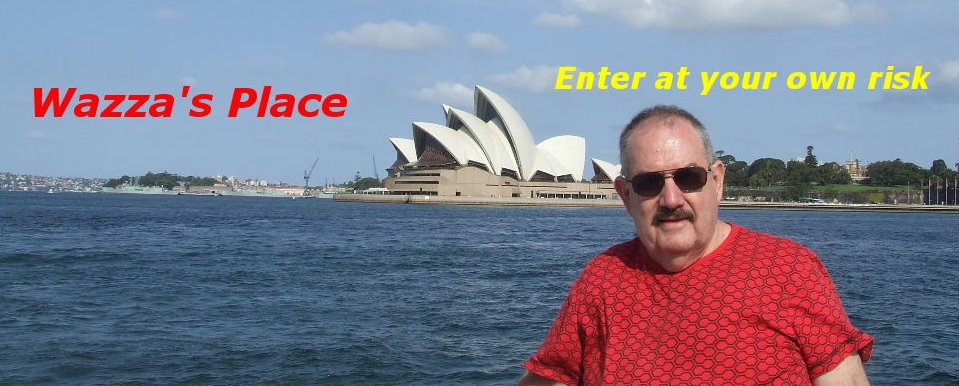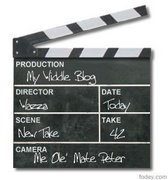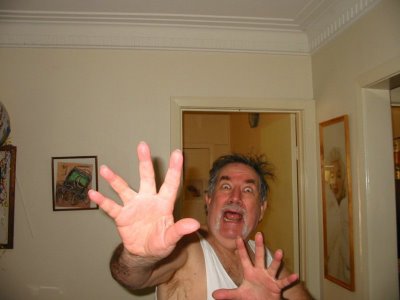Amberley RAAF Air Show 2008
Last Sunday 5th October, I went up to Amberley to see
the RAAF Air Show. I’ve been to the air show twice before,
the last time being many years ago.
Dave, at work asked if I wanted to join him to go and see
the air show. We decided to go on the Sunday. On the
Saturday TV news I saw the huge line up of cars heading to
Amberley. Interviewing some of the visitors I heard that
the 40km trip was taking up to 2 hours. Cripes, I thought
the
10.30 before we arrived not to mention the time it might
take to park and walk to the viewing area. We were
pleasantly surprised as there was no hold up and we
arrived in just under 35 minutes. Parking was controlled
by volunteer staff and we were soon inside ready to enjoy
the event.

There was a large display of static aircraft which were open
for inspection. The queues to go inside the airplanes and
helicopters were long and parents spent many a time
photographing their children sitting inside the cockpits.
Once the air display commenced the crowds surged
forward to the front fence eager to film the coming show
and what a show it was. The weather was excellent, clear
blue skies, temperatures fairly high and long shirt, hat
and sun screen was definitely a requirement.
The Royal Australian Air Force Base Amberley is located
in
and is the largest of
3,500 people work there.
Amberley was originally given its name by a farmer who
arrived from
in December 1938 as the site of the first permanent
RAAF station in

The Amberley RAAF Air Force Base went into operation
on
set up and No. 24 Squadron established. The squadron
received its first aircraft a De Havilland Moth Minor on
4th July.

.....................De Havilland Moth Minor.
Six days later, four Wirraways and a further two Moth
Minor aircraft were added. Both these types of aircraft
were built in
Personnel at the base hope their efforts will not be in vain,
as heavy rain washed out the 1996 show and the World
Trade Centre bombing led to the cancellation of the 2001
event. Wing Commander Rod Neilson said the base expected
to attract 50,000 to 60,000 people each day.
The cancellation of the previous two shows “have heightened
the interest in south-east
particularly as the last major air show was for the Air Force’s
60th anniversary in 1981.
Aircrafts on display and flying in the Air Show.
C-17 Globemaster
Hercules
F/A-18 Hornet
F-111
Hawk
Roulettes Aerobatic Team (PC-9)
Army Helicopters
Squirrel Pairs Display Team
Seahawk
War Birds

The C-17 Globemaster is a heavy airlift aircraft with the
capacity to carry a huge load. It can fly a very long time
without having to refuel, and can take off from and land
on dirt runways. This massive Boeing C-17 is Australia’s
largest strategic airlift freighter and is capable of transporting
a 77,500 kilogram payload.
The AP-3C Orion began as a passenger aircraft called the
Electra, which first flew in 1957. It was later converted for
military use in 1962. It is an extremely versatile aircraft
capable of many roles including maritime surveillance,
anti-submarine and anti-ship warfare, naval fleet support,
fisheries patrol, and survivor search and supply.
The Orion has a maximum speed of 750 km/h and can stay
in the air for up to 15 hours without refuelling. The power
of each of its four Allison turboprop engines is an enormous
4,600 horsepower. You would need approximately 20
six-cylinder family cars to generate the same amount of
horsepower as a single Orion engine.
Click to play video of The Roulettes Aerobatic Flying Team.
The PC-9 is the high-performance aircraft flown by the Roulettes
aerobatic team that you will see perform at the air show.
The Roulettes fly at speeds of up to 590 km/h and pull up to
6 'G' when performing aerobatic displays.
The Hawk 127 is primarily used for fighter training.
It has up-to-date instrumentation and weapons capability,
and is used to prepare aircrew to make sure they are ready
to fly the F/A-18 Hornet fighter or F-111 strike aircraft.
C-130 Hercules. 2008 is the 50th anniversary of C-130
Hercules operations in
participate on both days of the Air Show.
No 37 Squadron, based at RAAF Base
strategic and combat airlift. This aircraft is capable of lifting
20,000 kilograms and is currently deployed in the
The F/A-18 Hornet is a multi-role fighter aircraft that can
reach the amazing speed of 2,200km/h. It is capable of
flying for 2,700km without refuelling, but it can also be refueled,
while still in the air, by a KC-30B tanker aircraft when necessary.

................Rear view of the F-18 Hornet.

The F-111 is a supersonic long-range strike aircraft operated
by Nos. 1 and 6 Squadrons at Amberley. They have a swing-wing
that can be adjusted for different flight speeds, and when the
wings are positioned fully back, the F-111 can fly at more than
twice the speed of sound (the speed of sound is approximately
1,238 kilometres per hour).


Missiles on the F-111..........and the engine of a F-111.
The F-111 is affectionately known as 'the pig', because it can
fly so low using its terrain-following radar that it is said to be like
a pig with its 'nose in the weeds'.
Click to play video of F-111 Dump and Burn.
It often happens when one is taking video in a crowded
situation, somebody moves in from of the camera and this
was no exception as you will see an arm block the view of
the F-111 hurtling into the sky.
The F-111 will retire in 2010, so essentially it's performing its
last RAAF Amberley display.
It is a pretty important milestone as the F-111 has been a
mainstay here for 40 years and part of
capabilities since the 1970s.
The F-111 will remain in the RAAF's arsenal but will soon be
replaced by twin-seater F-18 Super Hornets, which are
expected to be on display at next year's air show.
The
aircraft whose speed and range revolutionized air transport
in the 1930s and 1940s. Early
American, TWA and Eastern ordered over 400 DC-3s.
These fleets paved the way for the modern American air
travel industry, quickly replacing trains as the favored means
of long-distance travel across the
War II, many civilian DC-3s were drafted for the war effort and
nearly 10,000 military versions of the DC-3 were built.
I’m showing a number of aircraft and helicopters that were on
display even though they were not part of the flying show.

.........Lockheed L1049 Super Constellation.


........Puma.................................................................................Tiger.
 ...............................................Seahawk Helicopter.
...............................................Seahawk Helicopter.


.....................Trojan..................................................Tiger Moth.
 .....................................Ultralight.
.....................................Ultralight.


This is the last photo I took as we left a little early before
the end of the show hoping that we would miss the exodus
of vehicles, and this we did.
I didn’t take many photos of planes in the air as I was also
taking video. I took about 25 minutes of video and I’ve
downloaded two small clips which I’m including in this post.
Should you have the opportunity of attending any of the air
shows that are flown in many parts of the world, I recommend
that you spare some time and enjoy the aircraft on the ground
as well as the display in the air.

















3 comments:
Very good Wazza, I even watched the two WG film clips, you certainly chose the right day to attend as Saturday would have been spoilt by the traffic snarls I reckon.
very nice blogs!
After Saturdsy's carpark on the Ipswich Motorway, it was nice that you were able to drive straight through on the Sunday. We're not far from Amberley, as the crow flies, and had jets flying overhead for the two days...more than usual, that is. That was a very interesting post, Warren.
Post a Comment